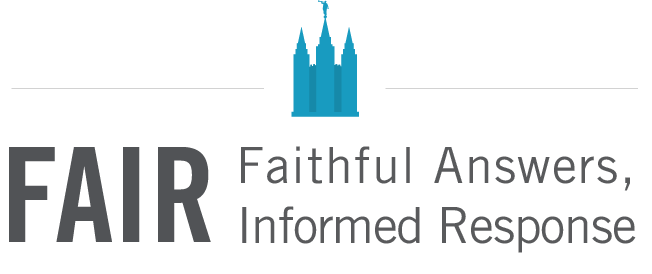
FAIR is a non-profit organization dedicated to providing well-documented answers to criticisms of the doctrine, practice, and history of The Church of Jesus Christ of Latter-day Saints.
m (bot - remove old references code) |
mNo edit summary |
||
| Line 3: | Line 3: | ||
<onlyinclude> | <onlyinclude> | ||
{{ | {{H2 | ||
|L=Understanding accusations of plagiarism | |||
|H=Understanding accusations of plagiarism | |||
|S= | |||
|L1=Question: How can one address accusations of plagiarism made about the scriptures? | |||
}} | |||
</onlyinclude> | </onlyinclude> | ||
| Line 38: | Line 43: | ||
===Conclusion=== | ===Conclusion=== | ||
It is the author's hope that this article will help all who are interested in providing a reason for the hope that is within every Latter-day Saint's heart of the truthfulness of the Restored Gospel of Jesus Christ and the integrity of its founding prophet, Joseph Smith. | It is the author's hope that this article will help all who are interested in providing a reason for the hope that is within every Latter-day Saint's heart of the truthfulness of the Restored Gospel of Jesus Christ and the integrity of its founding prophet, Joseph Smith. | ||
{{endnotes sources}} | {{endnotes sources}} | ||
Jump to details:
One of the primary methods of attack for critics of The Church of Jesus Christ of Latter-day Saints has been to accuse Joseph Smith (and other prophets who have revelations canonized) of plagiarizing different parts of his translations/revelations that have become part of the scriptural canon of the Church. There are different kinds of influence that critics allege outside sources had on Joseph Smith’s scriptural productions. Some point out mere conceptual resemblance. Others claim direct borrowing (like copy/pasting from other sources). Some believe that certain characters in the Bible provide a narrative structure for those in the Book of Mormon.
This article seeks to identify principles and procedures that Latter-day Saint defenders can keep in mind in order to address each of these accusations.
We should first lay out some general principles:
There are two very general ways that one can address plagiarism accusations. The first of these is to have a superior option for where something came from and the other is to have an equally plausible option for where something came from. We explain more below.
Everyone recognizes that the words and ideas in the scriptures had to come from somewhere. Latter-day Saints believe that they came from revelation given to prophets both ancient and modern. Critics believe they came from the mind of Joseph Smith and/or one or more of his associates. The first way to address accusations from a faithful perspective is to show that the Latter-day Saint perspective is the superior one given the historical data we currently possess. For instance, one can:
The other way to address a criticism is to have an equally plausible way for something to emerge. There can be claims of plagiarism that we neutralize rather than refute. Neutralization is an acceptable result of apologetic investigation. There are a couple of ways that we can accomplish neutralization.
It is the author's hope that this article will help all who are interested in providing a reason for the hope that is within every Latter-day Saint's heart of the truthfulness of the Restored Gospel of Jesus Christ and the integrity of its founding prophet, Joseph Smith.

FAIR is a non-profit organization dedicated to providing well-documented answers to criticisms of the doctrine, practice, and history of The Church of Jesus Christ of Latter-day Saints.
We are a volunteer organization. We invite you to give back.
Donate Now